Part 1
It was the spring of 1977. Having left an aquarium maintenance job with Exotic Aquaria in Coconut Grove, I had begun to work independently. I was delivering some new fish for a 360 gallon saltwater tank installed in a North Bay Village office near Miami Beach. It was in the offices of Diversified Industries, a somewhat shady company the employees dubbed “Diversified Thieveries”. This was my first custom installation and featured then state-of-the-art filtration package and a diorama background. There was a small elevated service area behind the tank where I could introduce the Clown Trigger and Emperor Angel I had just brought. I could see through the tank that the owner was entertaining some guests who were curious about the tank and the new fish. Once the fish were released I went into the office to explain about caring and feeding the new aquarium occupants.
It was then I was introduced to Dick Weldy, an American ex-pat who was living in Nicaragua. Dick was a Texan who was a big game hunter and guide and had lived in South and Central America. Presently he was working with the Nicaraguan government, running a horse slaughter house outside Managua that sold horse meat to the Japanese. I had no idea people ate horse meat, to me it was a bit repulsive, but he seemed like a nice guy who was interested in the fish. I later found out that Dick’s claim to fame was that John Wayne had married his ex-wife who he met in Peru while filming “The Alamo”. Indeed John Wayne’s 3rd wife was Peruvian, Pilar Pellete, and she was his wife till just before he died.
In addition to Dick there were two women introduced, one was Bunny Yeager, a well know Miami photographer, and her model Roberta. They had what appeared to be Zebra skins with them. They were there to do an advertising photo shoot with Roberta in a bikini reclining on the black and white striped hides. I soon found out that these were the hides of the slaughtered horses from Nicaragua, silk screened to look like Zebras. It was just another scam.
As Bunny and Roberta moved out to the deck which overlooked Biscayne Bay to set up the shoot, Dick was asking if I was a scuba diver. I told him I did dive and had done some aquarium fish collecting. He then asked if I had ever heard of Corn Island which I had not. It was a small island in the Caribbean about 40 miles off the eastern coast of Nicaragua. Dick had plans to put a dive resort there. The island was underdeveloped, but had airport access, and he thought it had great potential. He asked if I would be interested in doing some diving there to check out the reefs. The question was did it have enough pizzazz to attract diving tourists.
Nicaragua Coast and Corn Islands
It was entertaining watching Roberta pose on the fake zebra skins, even more so when she removed her bikini top. Bunny was snapping pictures fast as she could and Roberta responded with even better poses. It was hard to stay focused, but it was sinking in that I was about to go diving in Nicaragua. Roberta and I later became friends, but that’s another story.
It was only a few weeks later I found myself on a plane to Managua with a bag full of dive gear. Dick met me at the airport which featured armed guards and no air conditioning. Once I cleared the sweaty single line customs point we headed out to La Plancha restaurant for lunch. Dick insisted that Nicaragua was the safest and most stable country in Central America. The Somosa regime was very friendly to Americans, especially those who wanted to invest there. He had been there with his daughter a few years and the business climate was good. Most important there were no communist rebels which were plaguing other nearby countries at the time. Oh, there were Sandinistas, an old opposition force, but Somosa had them under control. I should have listened better as I chomped down on my Churassco steak. I liked the food and was quickly liking Nicaragua.
As we drove to Dick’s House I noticed how much damage was still visible in Managua from the earthquake of 1972. Many building were still crumbled and large sections of the city were abandoned. The aftermath of this earthquake was still being felt. Significant economic aid from the U.S, and its misuse by officials, triggered outrage and medial denunciation. No one, least of all me, noticed the seeds of revolution germinating in that rubble.
Dick Weldy lived on the shore of Jiloa Lagoon, an extinct volcanic crater lake just outside of Managua. As we drove up the view of the lake and surrounding crater walls was as exotic a location as I could imagine. He lived in a classic Spanish hacienda complete with tiled archways and a pet Oceleot. It was right on the lake shore. Dick told me about the local tales and legends of Lake Jiloa, how it had no bottom and was inhabited by strange creatures. Being mister science I joked about such superstitious nonsense, and since I had my dive gear with me announced I would make a dive to prove it.
I was breaking about every diving safety rule that afternoon. Diving alone, unknown location, just got off a plane, etc. The water had a sulfuric smell, and I could see bubbles breaking at the surface from underwater seeps. As I waded in from the beach and got under, I found the visibility was poor, about 10 feet. There was a silty bottom that sloped downward, so I began to follow it. I saw small white chichlids swimming around rocky outcrops, but not really much aquatic life. As I went deeper it was much gloomier and I was having a hard time seeing well. I stopped to check my depth gauge I found I was already at 100 feet! That slope had been almost straight down. That was too deep, so I turned to go back and found I had kicked up a silt cloud that totally obscured any view. I didn’t panic, but I do remember laughing at my situation, think narcosis. I took the best way out and did a direct ascent and found myself only about 20 yards from shore. My relieved host asked what I had seen. I told him I found no botton, there were strange fish, it dropped off fast and I was stupid to make the dive. Let the legends live on.
Jiloa Lagoon
The next day we left for Corn Island. Detached at the far end of Managua airport was the domestic terminal. The tiny building had a single counter and outside bench seating for the gate. Luckily our plane was there and we got right on board. It was an old DC-3, a reliable surplus WWII model. It still had signs in Chinese from when it was used to fly the hump in Burma. No two seats on the whole plane matched. We took off for our first stop, Bluefields, a coastal town on the Miskito coast. It was a quick stop to let off passengers, later I would get to know Bluefields well. As we vibrated our way across the Caribbean, I quickly got my first view of Big Corn Island. It was called Big because there’s a nearby smaller island naturally called Little Corn Island. As we approached my first impression was coconuts, lots and lots of coconuts. It matched all my cultural expectations of a tropical paradise. It had white beaches, lush vegetation, a mountain in the middle and a beautiful fringing reef. We landed on the dirt airstrip lined with jungle growing over old plane wrecks . The terminal was a brightly painted wood shack, our baggage mixed with boxes of vegtables. We grabbed our gear and found a “taxi” to take us to Dick’s recommended Lundy’s hotel on the South end.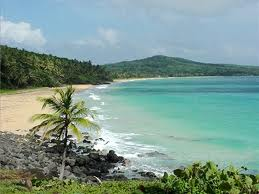
Big Corn Island Beach
Lundy’s was owned and run by an elderly American couple who had sold everything to live their dream in the Caribbean. They had worked hard to create a Caribbean island ambiance, individual cottages with thatched roofs and conch shell showerheads. But it was really a collection one room shacks with native art reflecting the Lundy’s idea of what island living should be. They were amiable hosts, who gave us all their attention as we were the only guests there. Business had been slow on Corn Island.
The next day the Lundys helped us find a local with a boat, ok skiff, to take these new touristas out to the reef. I loaded my dive gear with great expectations. The water around Corn Island itself is shallow and far from the edge of the continental shelf. My first dive was a bit of a disappointment, the depth was only 15-20 feet. I saw many of the common Caribbean reef fish and some huge elkhorn corals but the bottom was mostly flat and featureless. Rock rubble, today called live rock, abounded. There were no spectacular formations, caves, ledges or drop offs. But there was a lot of fish. I surfaced and asked Dick to hand me my collecting net. I went back down and caught a large Queen Angel and brought it up. I showed it to Dick and then went again and caught a net full of Bluehead wrasses using the old chopped-up urchin trick. We circled the island , making a dive here and there, it was pristine but all the same. As we came in I told Dick that I wasn’t sure about how a resort based on diving would do here, but it sure was a great place to collect fish. He answered by saying he could make that happen.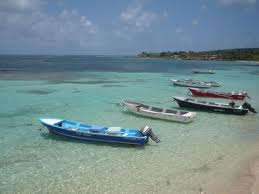
Fishing Boats on Corn Island
We spent a few more days exploring around and getting to know the island. Corn Islanders are a mix of West Indians, English and Miskit Indians, with a dash of Spanish government officials thrown in. They spoke mostly English because their heritage was more English planters and slaves than colonial Spanish. It is a very friendly place, but at the time also pretty primitive. No electricity, no paved roads, no TV or radio and very little communication. The main economy was centered on ProMarBlu, a large lobster and shrimp processing plant owned and run by the Somosa government. Shrimp and lobster boats would sell their catch to ProMarBlu who cleaned, froze and shipped it out to market. There was some copra produced there, but that was going out. President Somosa had a beach house on the island and was an occasional visitor. Otherwise it was a pretty laid back place. We left for Managua with plans to build a tropical fish collection station there. I’d soon be back.
PART II
Back in Miami I began to assemble the people and equipment it would take to build a collection station on Corn island. The project would be financed by the Diversified partners and Dick Weldy. One of the first problems was to find a good fish collector to bring with me. One who didn’t mind living, let us say, primitive. I knew a lot of collectors in the Florida Keys that sold fish to the livestock wholesalers in Miami. One was an old friend, Ernie Radloff, and his girlfriend Patty, who lived in Marathon. Ernie was building a house when he wasn’t collecting. He could tell you exactly what fish he had caught and sold to pay for each window and door. I approached him with the idea and he immediately signed on. Ernie’s expertise and enthusiasm would prove to be invaluable.
The other main problem would be assembling the equipment and getting it to Corn Island. There was a lot of gear involved. Dive equipment, holding and packing systems, basic living supplies, collecting nets and trays, the list got quite long. Instead of bringing Scuba tanks, which we couldn’t fill there, Ernie suggested a hookah compressor with air hoses. He used this kind of rig in the Keys and all you needed was gas to run the compressor engine. Next we came up with the idea that the crate we would use to ship everything could also double as the fish holding system. We built a wood crate that was fiber glassed inside and had a built-in filtration system with both 12 and 120 volt circulation pumps. Into it went all the necessities we could think of, it was compact and contained a complete fish station. We found an island shipping company that could take it as far as Bluefields, or more accurately El Bluff, which is where the Aduana (customs house) was located across the bay. Off it sailed and now we were ready to depart for Managua.
It had been decided that we would try and find a boat in Managua rather than have one shipped there. As it turned out Dick had a boat he was willing to lend us. It was an old Drummond Bulldog, built in 1970 by a company that built lake boats. About 20 feet long it was an inboard with an OMC outdrive. It hadn’t been run for years. Ernie, Patty and I were guests at Dick’s house at Jiloa. We figured that test running the Bulldog on the lake was a good idea, so we brought it up from storage and tried to get her running. Ernie was a pretty good mechanic and with a new battery and some help we got it fired up and launched into the volcanic lake. At first it was running great, pretty fast and stable. Then, with a bang, it just died. Turns out the outdrive was shot and it also leaked water at the exhaust headers. With no parts available the prospects were grim. But Ernie tinkered, he actually made wood shims to replace gaskets in the outdrive, and got it running well enough to take with us. The header leak was never fixed so we always had a cloud of steam billowing off the stern. The Bulldog was pronounced ready for Corn Island.
The other matter to attend was that of getting the proper fishing permits. This was going to take more effort and time than anyone thought. Dick had sent me off to the various government offices in Managua that could issue a permit. He had also introduced me to a young attractive Peace Corps volunteer he knew named Kelly. She was willing to help as a translator as I negotiated with Nicaraguan officials. It took weeks but finally we had arrived at the right guy’s office. I had brought a book with pictures of the reef fishes we were intending to collect. After many questions, and a few “gifts”, he agreed to issue a license, the first to be issued for saltwater tropical fish collection in Nicaragua. As I was leaving he had one more question. Why would anyone want to eat such small fish? The government was clueless.
We had acquired an electric generator from a friend of Dick’s in town. That was a big deal since there was no electricity on Corn Island and we would need it to run the fish system. We had found a transport company called the King Brothers who would trailer us and the boat to the East coast, or as close as we could get by road. The Chinese King Brothers had a small Toyota pick-up that could barely tow the Bulldog. We sat in the back flatbed for 180 miles as we travelled the countryside that featured volcanos and rain forest. We finally arrived in a town called Rama, which was about 40 miles from the coast. The road ended in Rama, and the only way forward was to navigate down the Rio Escondito which flowed into the Bluefields estuary. We launched the Bulldog into the river and tied her up at the dock of the Rama Hotel. After the long. bumpy drive we need to rest before the next leg of the journey. Our rooms cost one Cordoba each ( 25 cents US) and consisted of one cot with mosquito netting and a nail to hang your clothes. The next morning we ate some breakfast and fired up the Bulldog. Off we went down the river trailing a cloud of steam as the locals chuckled. They gave us little chance.
The Rio Escondito was small but beautiful. It meandered through tropical rain forests that showed virtually no sign of habitation. We were the only boat on the river, we saw no other traffic. Ernie didn’t push the Bulldog too hard, we couldn’t afford to break down here. It took most of the day but eventually the river widened, the jungle turned to mangroves and we could see the lights of Bluefields as the sun was setting. We found the city dock and tied up for the night. The next morning the first thing to do was run across the bay to El Bluff and see if our equipment had arrived. The Aduana was manned by the national guard and one customs official. After a little looking we found our crate and began the process of clearing customs. With a crowd watching the official began to remove everything in the crate. One by one he looked up the duty for each item in a large book. We had packed a marine radio and depth finder, but these were confiscated because they might end up in the hands of the Sandinistas. Otherwise it was eventually determined we had to pay $900 to get the equipment into the country. Since we had nowhere near that much on us, we had to leave the crate there with plans to come back with the money later. It was getting late in the day and we pondered our next move. We heard that there were two shrimp boats leaving for Corn Island soon, so we decided our best bet would be to follow them there.
We left the smooth waters of the bay to cross the 50 miles to Corn Island. The Bulldog rose and dropped to the ocean swell, its first time in saltwater. The shrimp boats were large and at first we could follow them easily. With no radio or other means of communicating we had to keep pace. But soon the shrimp boats were outrunning us and they became small specs on the horizon. Finally we lost sight of them. We kept our compass heading and in about an hour spotted Corn Island in the distance. As we approached we had missed the main dock and were west of the island heading up the north side. There was fringing reef with a break and we could find no channel leading into the island. Finally Ernie spotted a small break in the reef and we made it through. Going straight in to shore we saw a building jutting out into the water. With a puff of steam we beached the Bulldog next to it and tied up to a palm tree. We had landed right next to Morgan’s Hotel.
Mr. Morgan was a large bearded man with a booming voice. He loved to brag that he was a direct ancestor of Morgan the Pirate. He was a bit astonished that these three gringos had come through the reef right up to his beach, but was happy to have guests and sell us a meal. He was even more astonished to find out we were there to catch small colorful fish to send back to the states. Over the next few days he helped us with finding a location to set up our station. We found a wooden house right on the beach on the north side which would be a perfect place. It was owned by a widow, Romalda Siu Medina, who was thrilled to rent it to us for $100 a month. There was a dirt road out front and beyond the most beautiful grass flats I had ever seen. It was like having a saltwater lawn that you never had to mow. We moored the Bulldog on the flats about 50 yards off the beach and unpacked our bags. We were home in Corn Island.
The house had no kitchen, bathroom, running water or electricity. You could see between the planks that made up the walls. It did have a small building out back we could turn into the fish room. There was a well and a catch basin for rainwater from the roof. We wasted no time in getting it fixed up with a two burner stove and mounted an old toilet in a closet for the bathroom. It emptied into a hole we dug under the house. We rigged the generator to a couple of light bulbs hanging from the ceiling. In no time we had all the comforts, Corn Island style.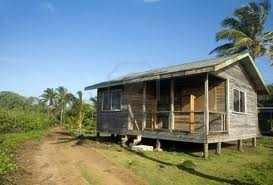
Corn Island Beach House
Soon we were ready to go out and actually collect some fish. The hookah compressor was mounted towards the back of the Bulldog with two 100 foot hoses that ended with a regulator and a harness. We had a small grappling anchor that could easily be moved by hand. Our method was basically to drift dive, boat and divers together, and manually set the anchor if anything caught our attention. We quickly came across small depressions that were filled with Royal Grammas, a popular purple and yellow basslet in the aquarium trade. Each would hang off the side of a ledge a foot or two, and as we approached they would dash into a small hole or under a ledge. We used quinaldine, a fish anesthetic mixed with alcohol and water, in a squirt bottle which either flushed them out or put them asleep. If you positioned your net just right they would swim right into it.
As we drifted and found other spots we saw all species of gobies, blennies, wrasses, tangs, angelfish and triggers. We saw rare species like the Golden Hamlet which could fetch a good price in Miami. Except for the fringing Elkhorn coral reef, it was an easy place to catch fish. There were few places for them to hide. For collecting shallow-water Caribbean species this was about as good as it gets. Our little collection station looked like it has a promising future.
By use of an old side-band radio at Morgan’s hotel we contacted our investors in Miami. We asked them to send the $900 to get the equipment cleared in El Bluff, and they wanted to come down and check on our progress. Amazingly there was a small bank branch on the island so the Promarblu employees could deposit their checks. The money came in and I was elected to fly back to Bluefields to get the crate cleared. Time was short as our investor would be there in a few days and expected to see a fully stocked fish system.
The docks at Bluefields were full of colorful small water taxi boats that ferried shipyard workers over the bay to El Bluff. I grabbed a ride in one and found my way to the aduana. After a few hours of paperwork and more inspecting I got the crate cleared. But then question arose, how would I get it to Corn Island? Customs told me there were no cargo ships scheduled to go to Corn Island, but wait long enough and something would come along. But the boss would be in Corn Island the next morning. My options were getting slim.
I had been reading “Zen and the Art of Motorcycle Maintenance” at the time. The cult classic was a story about trying to define quality. I sat on the dock of the Bluff reading a chapter that suddenly gave me an idea. I grabbed a water taxi and went over to the Bluefields docks. I literally ran down the dock asking every boat captain if anyone was going to Corn Island. Incredibly one said yes. His name was Livingston Bailey and he was going over tonight. After some fast negotiations we were on our way to El Bluff to pick up the crate. It was loaded and strapped to the foredeck as Captain Bailey’s small hold was already full. At the last minute the customs inspector came running out and asked if could carry 10 drums of gasoline to the island. These were tied along the deck rail amidships, opposite the pilothouse. We were riding pretty low in the water at that point. To make it even better there was a weather system moving in.
We headed out to Corn Island as the sun was setting. It started to rain and the seas became choppy. The single light bulb hanging from the roof of the pilot house swayed with the waves. Bailey had a mate who I hardly saw because he was always in the engine room. I went to the stern and looked down into the engine hatch. To my amazement he was sitting there holding a pan under the engine to catch the oil that was leaking out. When it filled he would then pour the oil back into the top of the engine. It was about at this point that I realized I was having an adventure.
We rode all night in rough seas, waves crashing over the bow. I read my book by the swaying light to keep my mind occupied with something other than impending disaster. Slowly we made our way and by sun up we were approaching Corn Island. I felt relief as we pulled into the main dock, and then spotted Ernie in a pickup truck owned by a friend. We unloaded the crate and rushed back to the house. Once unpacked, we carried the empty crate to the back room and set up the pump and filters. I paid some local kids to bucket saltwater from the beach and fill the system. Up to that point we had kept the fish we caught in perforated tackle trays placed in large net bags anchored over the grass flats. We brought the fish in, fired up the generator, started the pumps and bingo, a working fish station. Our investor was landing with minutes to spare, but it was done. We were in business on Corn Island.
Part III
As things settled down we began the routine of island life. The Bulldog would go out every day the wind wasn’t howling and good collecting spots were beginning to add up. Toward the end of the day it was common to spear something for dinner, the choice being fish or lobster. There was a big pot of black beans that was heated and re-heated, the older they got the better. Rice, beans and the day’s catch were standard everyday fare. Patty was really good at making campground doughnuts, our big treat. Some mornings we would wake up to horrible pig squealing in the distance. We knew there would be pork chops that night. Our neighbor was a Chinese store owner named Mr. Chen. He might have some chicken or even fresh veggies now and then, but mostly he stocked canned goods and soda.
Little Corn island was about 7 miles to the north. You could see it from our front porch. We had made a few exploring trips there and found a pristine staghorn coral reef at one end. The base of this reef was deep coral rubble with lots of nooks and crannies and tons of fish. If you looked into the spaces between the rocks occasionally you’d see a little face looking right back at you. These were Swissguard Basslets, a highly desirable aquarium beauty usually found in deeper waters. You could see them but how to get them out of such deep rubble? You could squirt them with quinaldine, but it would only drive them deeper (presumably knocked out). Ernie’s solution was to take a piece of stainless wire and attach a small gold hook with a crimped barb. With a little shrimp as bait you could actually fish underwater by threading the wire back into the staghorn rubble and hooking a Swissguard. Our fish keeps were full when we returned from Little Corn Island, and the basslets did fine despite a little hole in their lip.
A serendipitous distraction occurred one day as we were drifting along on hookah with the Bulldog. Searching for fish on a flat bottom suddenly, without warning, down below were cannons. They were big cannons, well encrusted, and almost in a pile. We could make out an anchor and what appeared to be a square corner covered in coral. It’s funny how fast your priorities can change, fish were forgotten now that we thought we found treasure. We dug around for a few days not finding much other than something we finally agreed was probably a horse stirrup. Using an air chisel attached to one of the hookah hoses, we attacked the box shaped reef. Inside were small horse shoes rusted together. Sorry no treasure. We later found out this was a well know 17th century Spanish wreck that had been carrying supplies to Panama and wrecked off Corn Island. President Somosa had one of the anchors on the beach in front of his house.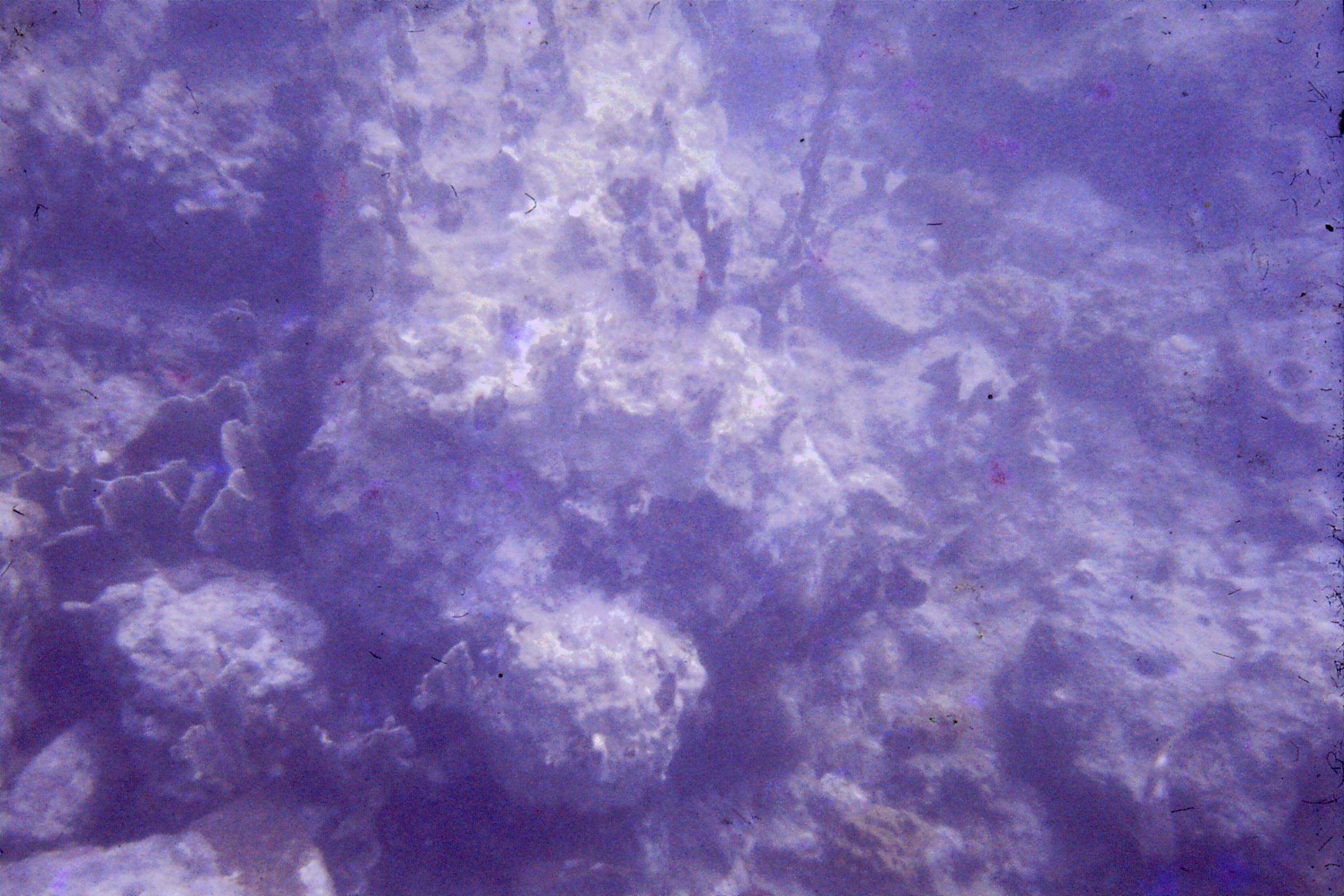
Breech end of Cannon off Corn Island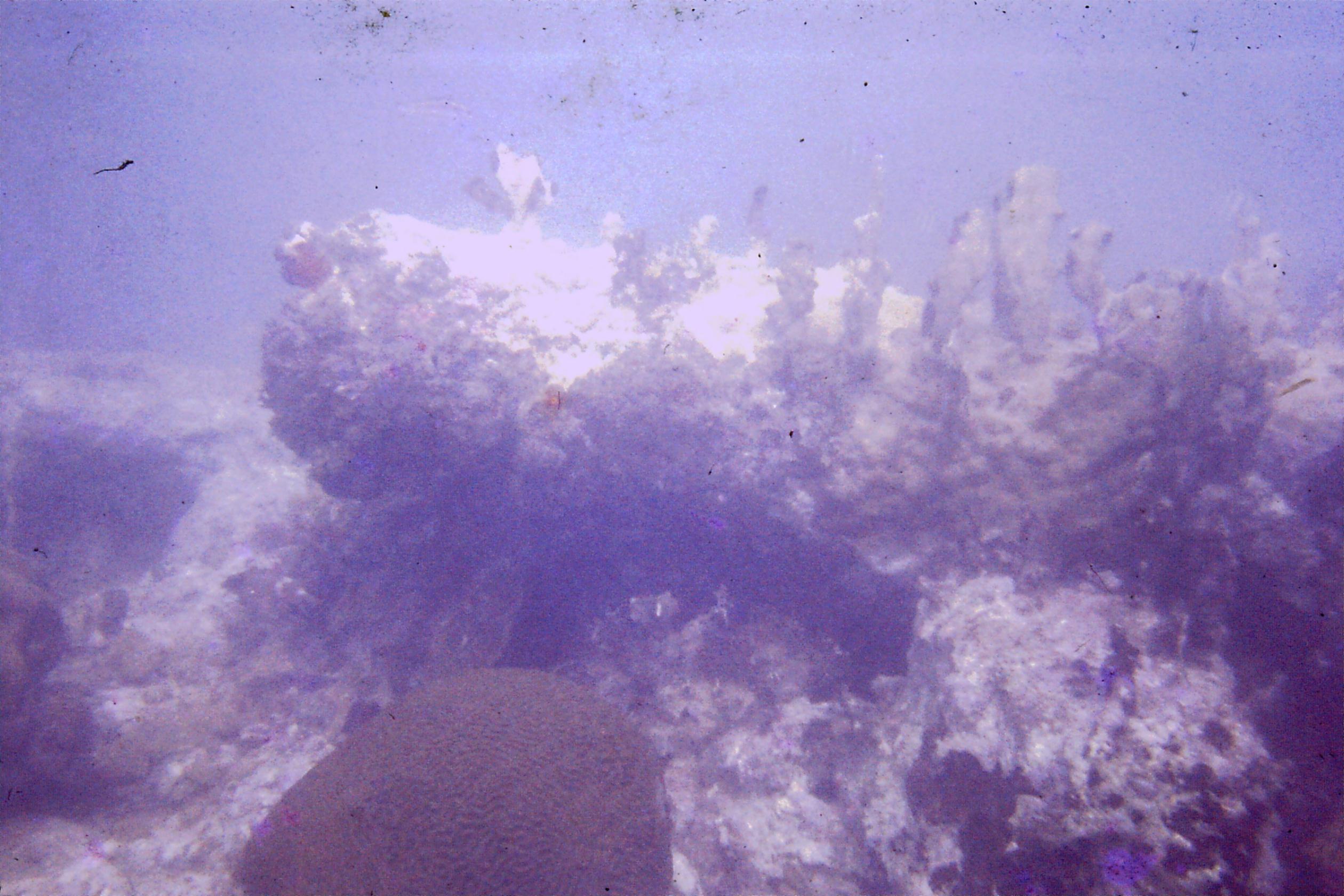
Cannon Muzzle on the Reef
The Corn Islanders were naturally curious about what we were doing. People would come by the house to look at the fish we had caught. There was always an interest in any means of making a living on an island with few resources. A few of the younger guys asked if they could go collecting with us. It was always our intention to train some of the local divers to collect so we welcomed them to join us. Collecting is not as easy as it might seem, fish are intuitive at evading capture. You had to learn their habits and use the bottom terrain to your advantage. Some divers quit, but two were getting the hang of it and beginning to catch a few fish. Juan and Antonio were accomplished lobster divers who were disillusioned at working for the government-run packing plant. At one point I told them I thought Nicaragua wasn’t as much a country as it was a big corporation run by Somosa. That struck a nerve, but I didn’t know it. The guys caught fish and we paid them, we were making progress.
The old DC-3 flew into Corn Island every Sunday morning, the only scheduled weekly flight. So Sundays became our shipping day, starting early with the generator running the packing station. We would pack the fish in plastic bags with oxygen and heat seal them closed. The fish were then boxed and taken to the airstrip. They would fly to Managua where we had a agent who would put them on an American Airlines flight to Miami. This agent, an American named Frank Biamonte, had been helpful in getting the license in Managua. He was a good contact because he knew where to find stuff and how to get things done in Nicaragua. It was through Frank that we began to hear about the rumblings of government protests. There had been some Sandinista attacks in the North, and they were getting more frequent. Somosa had an American equipped National Guard and no one thought these rebels would succeed in overthrowing him. This wasn’t going to last long, or so everyone said.
It was nearing Christmas and we had planned to go back to Miami for a break and see friends and family over the holidays. The shipments of fish had been arriving well, and we wanted to talk to Millie at All Seas, the wholesaler who was buying our fish. We flew out of Corn Island, made a connection in Managua, and in a few hours were back in the US. The whole project had gone fairly well and we all had high hopes for the New Year. We needed more fish and larger shipments to really begin to make the station profitable. Our buyer said she would buy more fish, our investors were pushing for larger sales, we knew what had to be done. The events of early 1978 however would present obstacles we never planned for.
Part IV
We flew back to Managua on January 9th, 1978. We had booked a connecting flight straight to Corn Island. The ol’ DC-3 took off almost on time and we were on our way to a promising year. What we didn’t know was that on that very day, Joaquin Chammaro, the editor of the opposition newspaper La Prensa was assassinated in Managua. It was thought that government operatives had carried out the attack. This was a keystone event that was to transform the country, the economy and our little station. We had flown out on what turned out to be the last scheduled flight to Corn Island.
The winter trade winds were blowing and the seas were rough, but it was good to be back in our little beach house. As the Bulldog rode the chop at anchor on the flats we found our equipment was in good order. The atmosphere on the island however had changed. The opposition Sandinistas had called a country-wide strike to protest Chammaro’s assignation in Managua. Most businesses had closed, and the island talk was focused on war and rebellion. With the few services and supplies the island offered now stopped, we were on hold, subject to the whims of a rebellion. There were few options other than to ride this out and wait until the government restored order. As the weeks went by it became obvious there wasn’t going to be a quick resolve, each day brought reports of new fighting and attacks. We decided it was time to get out, the question was how.
There were Mormon Missionaries on Corn Island we had met that had reached the same conclusion, time to leave for now. They had luckily been able to charter a private plane to take them back to Managua, and they generously offered us a ride. We flew out on a rainy day, jammed into a twin engine Cessna back to the capitol. We met up with Dick Weldy at the horse meat plant to decide what to do next. As with many other businessmen partnered with the president, Dick felt this little rebellion wouldn’t last much longer. He suggested we wait it out. Somosa’s National Guard was just too strong and the rebel Sandinistas didn’t stand a chance.
That night we met Lester, an American friend of Dick, who owned a blue jean factory in the free trade zone near Managua’s airport. He was a big friendly guy with a beard and happy to meet any fellow Americans. Once we told Lester of our predicament at Dinner, he made us an offer. His company, Million Dollar Baby Blue Jeans, would give us a couple of boxes of jeans and let us sell them on Corn Island. This would hold us over until the political problems passed. We could pay him for the jeans later. This seemed like the best deal we would get for now, so we took two big boxes of jeans and hitched a ride back to Corn Island on a cargo plane.
By this time the strike was fading and life on the island went on. Still, there was no chance of getting any fish out, so we set up our blue jeans store in the front room and got the word out. Astonishingly, our blue jeans were a hit. Islanders, Mesquite Indians and Spanish officials all stopped by for a new pair of jeans. We were selling pants to make the rent. An additional source of income was a Polaroid Camera we had, the novelty being that the film developed before your eyes. Many families had no access to cameras, or film developing, but they cherished a family portrait. So they would come to our house dressed in their Sunday best to have a Polaroid taken. We got $5 per picture, but to watch them see the picture develop was priceless. Our little business went through the Spring and Summer, and while we sporadically got out in the Bulldog, no fish left Corn island.
By the Fall of ’78 things were getting more serious. While no fighting had occurred on Corn Island, reports of the Sandinistas gaining victories over the National Guard were coming in from many parts of the country. The revolution was gaining momentum, and we could feel the inevitable outcome of rebel victory. Many, if not most, of the population of the island were favorable to the Sandinistas. They never liked the control of the Spanish government over their little paradise. Now that it seemed like Somosa might get overthrown there was little sympathy for him. If anything it caused a bit of celebration.
The revolution came to Corn Island one rainy night in September. The lightly guarded airstrip came under Sandinista attack and was captured. By revolution standards this was no big fight, more like a game of capture the flag. No shots were fired, but the morning brought the news that the rebels held the airport. Now there was no chance of ever shipping out fish, or for that matter no soon airplane exit from the island. There was never much fear that we would be a target, people were as nice as ever. As we later learned our fish collector trainees were rebels that had participated in the airport takeover. Collect fish by day, plot to overthrow the government by night, incredibly a reasonable lifestyle at the time.
So we decided to bug out, out of Nicaragua altogether. Hastily the Bulldog was fueled up and packed with just personal stuff. Everyone really thought we would be back some day, so we left the equipment, except the generator, and said our good buys. We then headed out across the 40 miles of open ocean to Bluefields, gently pushing the Bulldog as she steamed her way across. The wind was light, the seas calm, and luckily we docked in Bluefields in a few hours. No officials, or guards or dockmaster greeted us, and that was good. We wanted to keep moving. Heading North in the lagoon we re-entered the Rio Escondito and worked our way up to Rama. This was getting tricky because now we were in areas where fighting was going on. It had been arranged for the King Brothers to meet us and sure enough we saw their truck at the Hotel Rama. The Bulldog was put back on the trailer, we in the bed, and ahead lied 180 miles of bad roads and revolution. The atmosphere was gloomy as we sat in the bed of the tiny Toyota pick-up. Slowly we were accepting that all the efforts to start our little station were ending by events way out of our control. By the end of a long, bumpy but uneventful trip we just wanted out.
We had delivered the Bulldog and the generator back to Dick, when he told us the news about Lester. Our blue jean supplier been shot in a fake road stop by Sandinistas and was back in Miami, taken by jet ambulance. At this point even Dick was conceding that things we not looking good and he was about to close the horse plant and leave. We managed a few days in Managua before flying back to Miami. A few years later I bumped into Lester leaving a movie theater. He was in a wheelchair, had lost weight, and was lucky to be alive. We had faked being dead, and was later found in a ditch and rescued. His brother, a doctor, had flown in to save him. He was paralyzed but in good spirits and still making blue jeans.
In the end we felt a sense of relief, accomplishment, dismay and of having shared an incredible experience. There was a small financial loss, but that paled to what might have happened. We never went back to Corn Island. Nicaragua went through years of government turmoil, communist rhetoric and finally held elections that brought some stability. The Sandinistas are still in charge, but the country is again a beautiful safe place to visit.
I was lucky enough to go back in the Summer of 2007. A full 30 years later there were noticeable improvements, the roads were paved, they had electric power and cell phones. But the old laid back atmosphere is still prevalent. It was good to talk with some of the old timers, some that even remembered the crazy fish collectors from America. I did some diving and it was good to see that the fringing reef still has healthy stands of Elkhorn coral, a species that is dying out in many parts of the Caribbean. I even found the old cannons still in the same spot. The Corn Islands are now considered to be a prime dive site in the Caribbean, unspoiled by civilization. I can only hope they stay off the beaten track.
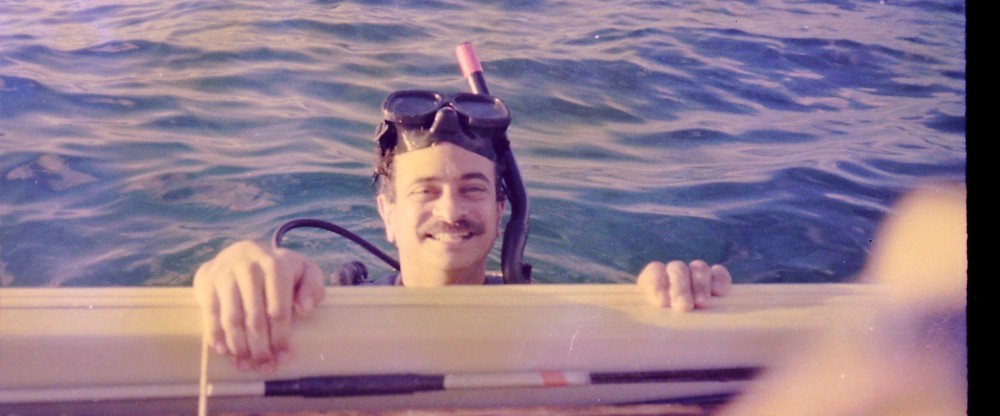

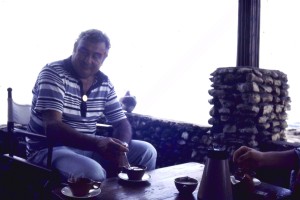
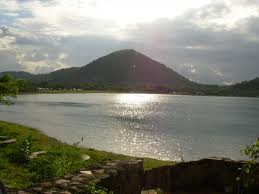
Hi Vince, Judy sent this to me this morning and I have read it three times. It’s like going back in time. Tom was my husband and of course Ernie my brother-in-law.
Corn Island is my most favorite place in the world, I would love to go there once more but that will probably never happen. (unless I win the lottery).
The island was, as you said, very quaint. I always said it was being back 50-60 years ago but I truly loved it. We purchased property there with Ernie but after the
Sandinista’s took over it was lost, as far as I know. Ernie went back to check it out but no use.
Thank you so much for this wonderful account of the island adventure. If you ever
go back I would love to hear about it in your eloquent writings.
I hope this finds you well and happy and still venturing….happy trails. Linda
Linda, glad you liked it, one of my favorite “adventures with Ernie”. I did get to go back in 2007 and in many ways it did feel the same. Now with paved roads, electicity and cell phones it’s a lot easier. The Reefs are still pristine and the people friendly but you could never duplicate that experience.
I’m trying to write up a few more fish tales, there’s more Ernie to come.
Vince> Great write up about your experiences.. Judy just sent me this and I read it over dinner–remindes me much of my experience in Haiti, Bahamas and Colombia trying to set up tropical fish collecting stations. Don
Don, thanks, it was my pleasure to work with Ernie not only on Corn Island but Brazil and Andros too. Bought many of the loads he brought back from Cal Sal . I’m trying to put all this down, it’s a way to look back and remember Ernie and lots of others, and tell the fish tales to the wired generation. I know you have many similar experiences and probably look back with a smile as I do.
Vince, although Ernie told many tales of Corn Island; it was so nice to read it in such detail. Thanks for sharing, and thanks for helping keep the memory of such a unique person alive.
Judy, this is starting to get around and I’m getting some very nice comments. It just spurs me on to write more. Upcoming Ernie stories include Brazil and the crazy station we tried on Andros in the Bahamas.
Ernie’s memeory is alive in me.
Great story Vince! This brings back memories of one of my Central American adventures. I was on Big Corn at the beginning of the Sandinista revolution as well, living and working with Jorge Morgan who had the other big lobster facility on the island. I must have walked by the house you and Ernie had a few times – but never met you guys. When the last DC-3 left the island they would only take passengers to Puerto Cabezas – so I caught that ride and then spent the next 5 days with my suitcase on my head walking through the jungle to Puerto Lempira in Honduras. Having spent time in the Mosquitio Coast before – this was a preferred escape route for me! Then when I got into the marine tropicals in Florida (1988) and you worked for International Fisheries we finally met. The State stopped the live rock biz and I returned to the Bay Islands in Honduras to ship live rock to Miami. I might detail that story on my website soon – there are already several of my adventure stories there now: http://www.naturalhistorymall.com/fieldnotes.html